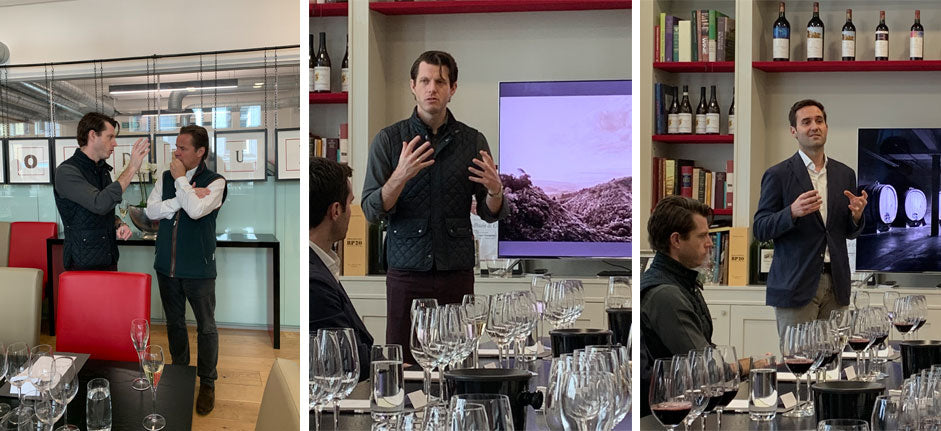
With the busy Burgundy 2018 campaign winding down, we look towards the superb releases coming out of Tuscany and Piedmont. But first, some lunch!
This week we had the pleasure of welcoming the team from Promontory Wines to Goedhuis HQ. A relaxed masterclass over some lunch had us tasting a vertical of their Napa Valley Cabernet Sauvignons. From vintage 2011 through to 2014. Promontory is a sister winery and the latest venture of the great Harlan Estate. Its founder Bill Harlan was a tireless crusader for the Golden State’s place in the wine realm. Today, his son Will is taking on the mantle at Promontory and, much like the Harlan Estate wines, they have become Californian cult classics.

The Promontory vines sit on wild forest land that Will’s father discovered on a hike in the early 1980s. The terrain is very steep and rugged; this is by no means the easiest place to grow your grapes. But, as Will Harlan and winemaker Cory Empting explained to us, there are two great advantages to this location. Firstly, two separate fault lines run under the land here and give hugely varied soils: rare is it to find a location where all three soil types (igneous, metamorphic and sedimentary) converge. The high-altitude (150 metres +) forest land creates condensation and fog that is moved by a constant, changing airflow. The result is wines with great structure and complexity but also freshness.

The Austrian oak that Cory has used to age the wines since 2013 and 2014 gives a stunning texture. Cory told us that after visits to Barolo and Barbaresco, tasting wines at such domaines as Paolo Conterno and Vietti, he became intent on sourcing the same large Austrian oak casks for Promontory.

The Stockinger casks from the Alpine foothills have a certain neutrality to them, explained Will, that ensures the wines aren’t overwhelmed by sweet vanilla oak flavours that French and American barrels can impart. As Cory puts it, “Promontory doesn’t need oak, it needs time”. The five-and-a-half-year release cycle that the estate operates is testament of this: these are stunning and hugely complex wines that are allowed to speak for themselves. If you get a chance to try them, make sure you do!
A big thank you to Will, Cory, Gaelle and Joe for a very informative and delicious experience. See you again soon.
Here are Will Harlan’s exceptionally eloquent notes on the wines we tasted:
2011 Promontory, Napa Valley
Deep red and brooding describes both the appearance and nature of the wine. The 2011 vintage bears the most extroverted aromatics of Promontory to date, with notes that range from coffee, black truffle, wet stones, and the smell of warm earth after a rainfall. The wine is classically juicy on entry as the acidity dances in the front of the mouth. It possesses great density but demonstrates a degree of clarity and intention as it touches the mid-palate. This is followed, by a very fine quality of tannin, not yet experienced in the prior vintages. The 2011 is undoubtedly youthful, but with gentle decanting it can bestow more pleasure at the moment than any vintage yet. However approachable this wine may be, we are convinced that its mysterious facets will continue to be revealed in the decades to come.
2012 Promontory, Napa Valley
A rich garnet color and youthful brilliance define the appearance in glass. As is typical with the youthful wines of Promontory, the nose is subtle yet intricate. Several minutes after pouring, the different facets begin to emerge. Though one might discern distinct aromas of wet stone, cassis, and hints of resin, the nose seems to more appropriately transport one to the place itself. There is a feeling of moist fog, bringing both humidity and the scents of the native landscape, while projecting in the mind’s eye a vision of sunlight without heat. On the palate, this vintage is decidedly forward. The acidity is forthcoming on entry and balanced by the sheer muscle and density of fruit. The tannins have a chiseled definition, but remain soft and pliant, delivering a long and persistent finish. While the 2012 reveals its precocious virtues, it is unable to hide the underlying truth that patience will provide great reward.
2013 Promontory, Napa Valley
Aromas are diverse and complex, with no single primary scent standing above the rest. Some of the more subtle facets are beginning to surface: wet stone, graphite, leather, and fresh spices. Brighter notes create a tension in the nose that then transfers to the palate. In the beginning it is gentle and silky, developing slowly and purposefully into a synthesis of minerality, freshness, and vibrancy. The wine shows its potential for aging with a balance of structure and lightness, as well as a latent potential only to be revealed with time.
2014 Promontory, Napa Valley
The appearance is deep red with a brilaint reflection along the rim. On the nose, hints of graphite, wet stone, and fresh spices interplay with a fruit component that brings notes of fresh, dark berries, notably cassis. The wine begins with precision and tension, as mineral acidity drives linearly from the front to the back of the palate. The tannins, gaining defintion, are harmoniously integrated with density and freshness of the fruit, creating a long and vibrant finale. Elegance and controlled strength are wrapped in the now-familiar structure of Promontory, resulting in a wine with an athletic balance that will drink beautifully over the next 50-plus years.


